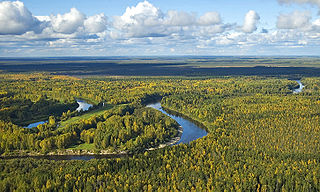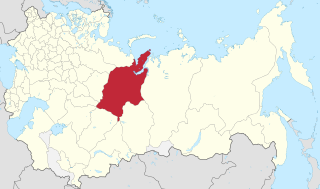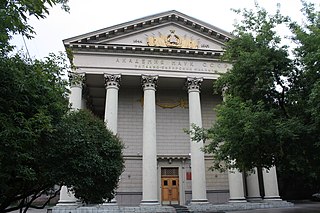
The Trans-Siberian Railway, historically known as the Great Siberian Route and often shortened to Transsib, is a large railway system that connects European Russia to the Russian Far East. Spanning a length of over 9,289 kilometers, it is the longest railway line in the world. It runs from the city of Moscow in the west to the city of Vladivostok in the east.

Novosibirsk Oblast is a federal subject of Russia located in southwestern Siberia. Its administrative and economic center is the city of Novosibirsk. As of the 2021 Census, Novosibirsk Oblast had a population of 2,797,176.

Omsk Oblast is a federal subject of Russia, located in southwestern Siberia. The oblast has an area of 139,700 square kilometers (53,900 sq mi). Its population is 1,977,665 with the majority, 1.12 million, living in Omsk, the administrative center.

The West Siberian Plain is a large plain that occupies the western portion of Siberia, between the Ural Mountains in the west and the Yenisei River in the east, and the Altai Mountains on the southeast. Much of the plain is poorly drained and consists of some of the world's largest swamps and floodplains. Important cities include Chelyabinsk, Novosibirsk, Omsk, and Tomsk, as well as Surgut and Nizhnevartovsk.

Russia is divided into twelve economic regions — groups of federal subjects sharing the following characteristics:
Geographically, Siberia includes the Russian Urals, Siberian, and Far Eastern Federal Districts.

National Research Tomsk Polytechnic University (TPU) is a technical university in Russia. TPU was a member of 12 international associations, including the Conference of European Schools for Advanced Engineering Education and Research (CESAER) until it was suspended in March 2022, and the European University Association (EUA) until it was suspended in March 2022. TPU was included in Project 5-100, a 2013 state program aimed at bringing at least five Russian universities from among the project participants into the 100 best universities in the world.
Education in Siberia expanded greatly after the Trans-Siberian Railway was completed in the 19th century. While Siberia became part of Russia in the 17th century it was not until the 20th century under the Soviet Union that education was transformed which in turn brought Siberia to economic importance. This was aimed at uniting people under the Soviet. For example, the Irkutsk State Linguistic University served as "a conduit between Russia and these native people by teaching languages" during the communist era. Imperial Russia began uniting Siberia to Russia by founding Siberia's first university, Tomsk State University, in 1878.

The West Siberian Economic Region is one of the twelve economic regions of Russia.

Western Siberia or West Siberia is a region in North Asia. It is part of the wider region of Siberia that is mostly located in the Russian Federation, with a Southern part in Kazakhstan. It lies between the Ural region and the Yenisei River, which conventionally divides Siberia into two halves.

Russia, the largest country in the world by area, has international land borders with fourteen sovereign states as well as 2 narrow maritime boundaries with the United States and Japan. There are also two breakaway states bordering Russia, namely Abkhazia and South Ossetia. The country has an internationally recognized land border running 22,407 kilometres (13,923 mi) in total, and has the second-longest land border of any country in the world, after China. The borders of the Russian Federation were mostly drawn since 1956, and have remained the same after the dissolution of the Soviet Union. In 2014, Russia annexed Ukraine's Crimean peninsula in a move that remains internationally unrecognized.

Nikolai Mikhailovich Yadrintsev was a Russian public figure, explorer, archaeologist, and Turkologist. His discoveries include the Orkhon script, Genghis Khan's capital, Karakorum and Ordu-Baliq, the capital of the Uyghur Khaganate. He was also one of the founding figures of Siberian regionalism.
Tsentralny, Tsentralnaya, or Tsentralnoye is the name of several inhabited localities in Russia.

Tobolsk Governorate was an administrative-territorial unit (guberniya) of the Russian Empire, Russian Republic and Russian SFSR located in the Ural Mountains and Siberia. It existed from 1796 to 1920; its seat was in the city of Tobolsk, and from 1919 to 1920, in the city of Tyumen.

Siberian Tatar is a Turkic language spoken in Western Siberia, Russia, primarily in the oblasts of Tyumen, Novosibirsk, Omsk but also in Tomsk and Kemerovo. According to Marcel Erdal, due to its particular characteristics, Siberian Tatar can be considered as a bridge to Siberian Turkic languages.

Tomsk Governorate was an administrative-territorial unit (guberniya) of the Russian Empire, the Russian Republic, and the Russian SFSR, which existed from 1804 to 1925 as part of Siberian Governorate-General (1804–1822) and West Siberian Governorate-General (1822–1882). Its capital was in Tomsk.
Vladimir Ivanovich Starstenko was a Russian politician, statesman, economist, railway operator, and engineer who had served as the Head of the Moscow Railway from 2002 to 2009. He was also the Head of the West Siberian Railways from 1997 to 1999, and again from 1999 to 2002.

The West Siberian Branch of the Academy of Sciences of the Soviet Union was a Soviet research institution, a branch of the Academy of Sciences of the Soviet Union, that existed from 1944 to 1958. Its head office was located in Novosibirsk. The organization preceded the establishment of Novosibirsk Scientific Center of the SB AS USSR.

The Flag of Siberia is the unofficial flag used to represent the region of Siberia. This flag first became widely used during the Russian Civil War and the short-lived Siberian Republic. After it failed, the flag continued to represent sentiments of Siberian regionalism.















